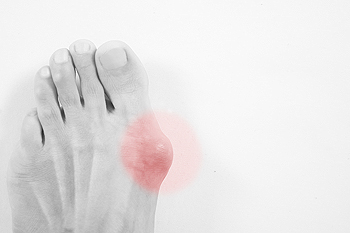Can Bunions Develop as a Result of Having Arthritis?
Monday, 28 October 2019 00:00 A large bump on the side of the big toe may indicate that a bunion has developed. It is considered to be a deformity, and calluses may form on the top as a result of friction against shoes that are worn. Additionally, blisters may appear, and it may become painful, red, and swollen. Common causes why bunions can develop can consist of genetic factors, and wearing shoes that do not have adequate room for the toes to move freely in. Research has indicated that patients who are afflicted with arthritis may notice a bunion forming over painful joints in the big toe. There may be methods that can be implemented which may help to prevent bunions from developing. These can include wearing shoes that have a lower heel, and avoiding backless shoes. If you have a bunion, it is suggested that you seek the advice of a podiatrist who can offer you correct methods of treatment.
A large bump on the side of the big toe may indicate that a bunion has developed. It is considered to be a deformity, and calluses may form on the top as a result of friction against shoes that are worn. Additionally, blisters may appear, and it may become painful, red, and swollen. Common causes why bunions can develop can consist of genetic factors, and wearing shoes that do not have adequate room for the toes to move freely in. Research has indicated that patients who are afflicted with arthritis may notice a bunion forming over painful joints in the big toe. There may be methods that can be implemented which may help to prevent bunions from developing. These can include wearing shoes that have a lower heel, and avoiding backless shoes. If you have a bunion, it is suggested that you seek the advice of a podiatrist who can offer you correct methods of treatment.
If you are suffering from bunion pain, contact Dr. Lee R. Stein of Lake Shore Foot & Ankle, PC. Our doctor can provide the care you need to keep you pain-free and on your feet.
What Is a Bunion?
Bunions are painful bony bumps that usually develop on the inside of the foot at the joint of the big toe. As the deformity increases over time, it may become painful to walk and wear shoes. Women are more likely to exacerbate existing bunions since they often wear tight, narrow shoes that shift their toes together. Bunion pain can be relieved by wearing wider shoes with enough room for the toes.
Causes
- Genetics – some people inherit feet that are more prone to bunion development
- Inflammatory Conditions - rheumatoid arthritis and polio may cause bunion development
Symptoms
- Redness and inflammation
- Pain and tenderness
- Callus or corns on the bump
- Restricted motion in the big toe
In order to diagnose your bunion, your podiatrist may ask about your medical history, symptoms, and general health. Your doctor might also order an x-ray to take a closer look at your feet. Nonsurgical treatment options include orthotics, padding, icing, changes in footwear, and medication. If nonsurgical treatments don’t alleviate your bunion pain, surgery may be necessary.
If you have any questions, please feel free to contact one of our offices located in Chicago, Highland Park, and Uptown, IL . We offer the newest diagnostic and treatment technologies for all your foot care needs.
Blog Archives
- April 2025
- March 2025
- February 2025
- January 2025
- December 2024
- November 2024
- October 2024
- September 2024
- August 2024
- July 2024
- June 2024
- May 2024
- April 2024
- March 2024
- February 2024
- January 2024
- December 2023
- November 2023
- October 2023
- September 2023
- August 2023
- July 2023
- June 2023
- May 2023
- April 2023
- March 2023
- February 2023
- January 2023
- December 2022
- November 2022
- October 2022
- September 2022
- August 2022
- July 2022
- June 2022
- May 2022
- April 2022
- March 2022
- February 2022
- January 2022
- December 2021
- November 2021
- October 2021
- September 2021
- August 2021
- July 2021
- June 2021
- May 2021
- April 2021
- March 2021
- February 2021
- January 2021
- December 2020
- November 2020
- October 2020
- September 2020
- August 2020
- July 2020
- June 2020
- May 2020
- April 2020
- March 2020
- February 2020
- January 2020
- December 2019
- November 2019
- October 2019
- September 2019
- August 2019
- July 2019
- June 2019
- May 2019
- April 2019
- March 2019
- February 2019
- January 2019
- December 2018
- November 2018
- October 2018
- September 2018
- August 2018
- July 2018







